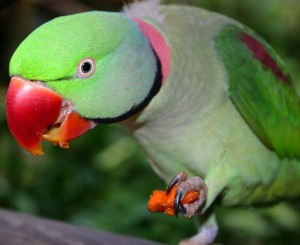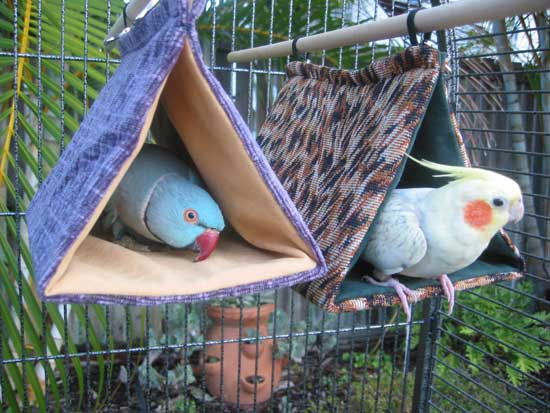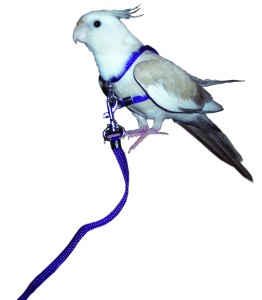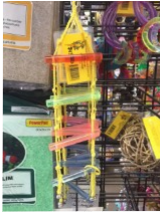Alexandrine For Sale Sydney
Natural Distribution
Alexandrine parrots naturally occur in India, China, Afghanistan, western Pakistan and the Andaman Islands. Their natural habitat is low land wooded areas such as jungles, forests and coastal mangroves.
Description and Sexing
The Alexandrine is a large parrot measuring up to 58 cm all green with a long tapering tale. The head is large with a strong red beak. The male has a black ring around the neck and has a blue-grey sheen through its cheeks and nape. The male takes 2 years to get their adult plumage so young birds all look like females. The most effective way of telling the gender of these birds as juveniles is DNA sexing them though you can often tell with young birds as the male has a head which is a bit larger than the female.
Life span
Around 35 years
weight-
200 – 300 grams
Care and Feeding Alexandrine Parrots
In the wild these birds feed on a variety of seeds, leaf buds, fruits, nuts, blossoms and insects.
In captivity fresh food and water must be provided daily. To keep your birds healthy feed, them a diet of small parrot mix with fresh fruit, veg, nuts, cooked beans, cooked rice, meal worms and soaked seeds.
The cage requires regulars cleaning and old food shouldn’t ‘be allowed to accumulate in the cage, on perches or in feeders. Water should be changed daily basis. Do not allow fruit and veg to go moldy.
Housing
Like all birds the bigger the cage the better alexandrines need a large cage if kept inside as they are a large parrot birdsville has many cages suitable for these birds.
Alexandrines are very active, playful birds and require room for many toys, perches, food/water dishes, as well as sufficient space for them to move around.

Alexandrines as Pets
These birds are not only large and beautiful they also have great mimicking ability. These birds are intelligent and make a wonderful family companion provided there is regular handling and training. The owner of a tame Alexandrine must be prepared to give these birds the correct sized large cage to stretch their wings with at least 3 or 4 toys and a swing changing toys from time to time as boredom will eventually cause these birds to feather pluck or squark excessively which is much easier to prevent than cure.
Introducing your new bird to existing birds
Once you take your bird home you should keep it in a separate cage and allow the bird to adjust accordingly. Always allow at least 2 weeks before introducing the bird to existing birds. During this 2 week wait allow the birds to see and hear each other through the cage to give them a chance to get comfortable.
Worming
Your bird will need to be wormed in a few weeks to two months after being taken home (check with the staff from Birdsville, when purchasing). Young birds that have been recently weaned have a delicate bacteria’s developing in their gut, worming at this stage could harm the bacteria’s development and your new bird. Worming will need to be done.
every 6 months. Worming your bird is essential for the health of all parrots in captivity.
Lice & Mites
These are the two most common parasites of cage birds and their environment but are easily controlled with a Mite and Lice spray, available at Birdsville. When using spray, spray bird, entire cage, perches, nesting box and toys, remember to remove all water and feed and avoid spraying in birds’ eyes. Your bird Lice and mite bottle will explain how to use, remember avoiding the mouth and eyes.
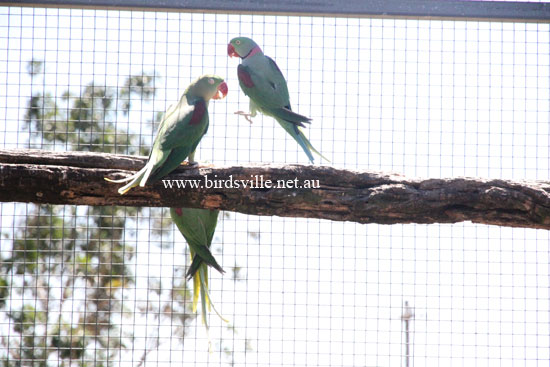
Training Your Bird
Training is an important factor of having a well-behaved hand raised bird. When you first get the bird home, let it settle down and get use to their new environment for a day or two. After these initial days, the bird should be handled in a quiet, relaxed situation. Spending time with your bird while watching TV or reading is perfect, but don’t over stress your bird in the first few weeks of taking it home, babies need their rest. The more time you spend with your bird, the better your bird will become.
When doing any training there are three basic concepts to keep in mind.
- When the bird does something good –> give it a reward.
- When the bird does something undesirable –> ignore it.
- Never punish your bird
Start training your bird with a simple command, like step up.
Have the bird on one hand, place the other hand against the birds’ chest and say the command, step up, as you apply a slight pressure to the birds’ chest. The bird will then put one leg up, pull slightly up with the second hand and the other leg will follow, reward your bird with a treat, like a favorite fruit, seed or nut. Then repeat, as the bird gets better, get it to step up a few times before rewarding. Once your bird catches on to it, instead of rewarding it with food, reward it with praise. This will soon become second nature to the bird.
It is important not to overdo the training, keep it short, but frequent.
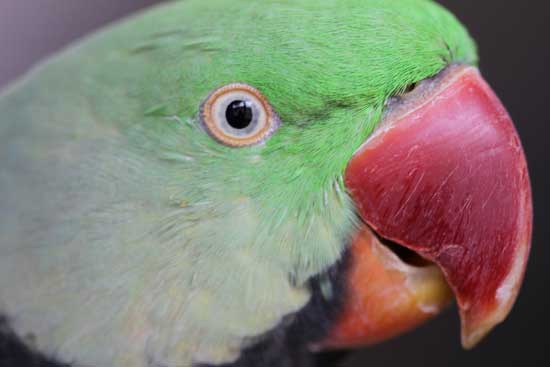
Hand raised Alexandrine can make loving and affectionate pets. They love interacting with their owners, they are highly intelligent and make good talkers, when trained through repetition. They have a tendency to become “one-person” birds, forming a strongly bonding to their favorite family member while shunning others within the household. Training and correct socialising techniques, will avoid this possibility. Like most parrots, they can go through a hormonal stage especially during breeding times of the year and during their adolescence. Many owners of a newly acquired baby Alexandrines find this stage difficult. Its very important to stick to your guns and continue socialization training and bonding with your bird.
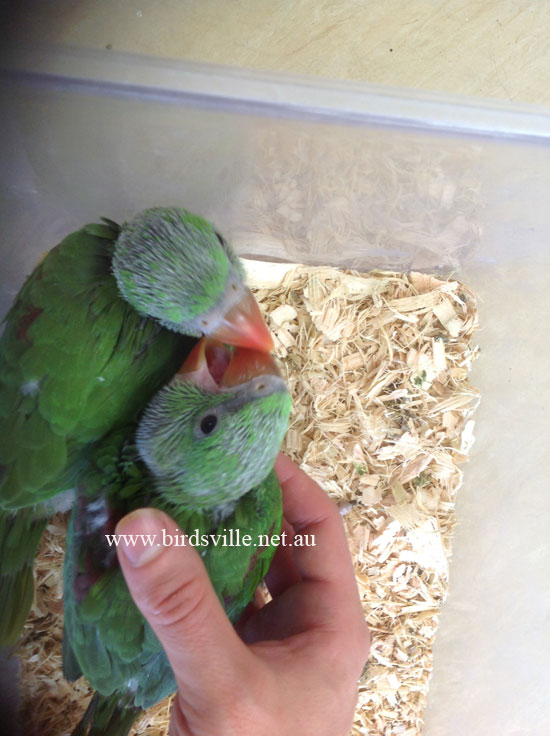
Availability at Birdsville
Hand raised baby Alexandrines are only available one time a year, around November/December as they are seasonal breeders. Adult hand raise birds come into the shop from time to time. If you are interested in owning one of these birds give us a call or visit us for at chat at Birdsville.
Distribution and Habitat of Alexandrine Parrot’s
Alexandrine’s originated from mainly northern India, but this species has naturalized itself in numerous European countries, including Germany, south of England, Belgium, Greece, western Turkey and the Netherlands. Where they live side by side with flocks of Indian Ringnecks which were also introduced.
In the wild they live in deciduous forests, farmlands as well as parks and gardens in urban areas. They are very social and live in small groups ranging between 8 and 20 birds.

Description
The Alexandrine’s are a medium sized green parrot. Many reach a length of up to 25 inches, although much of this length is accounted for by their long, elegant tail feathers. Their body is quite slender for a parrot and has a large strong red beak. they are often confused with their smaller Cussen the Indian Ringneck. The male Alexandrines develop a black and pink ring around their necks after two years of age. This is only way to tell the sex of the bird, unless using DNA and surgical sexing.
Breeding
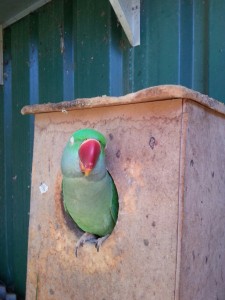 Eggs 2 to 4 and incubated for an average of 28 days. The chicks fledge around 7 weeks of age which means they have grown most of their size and feathers but are still dependent on their parents for food. Adult Alexandrine will continue to feed the babies after they have left the nest and are able to fly. The fledglings are not weaned until around 10 to 12 weeks of age. It is very important that during the entire breeding process that you increase the volume of food that is fed to your birds with lots of fresh fruit and veg. At Birdsville we recommend pass well soft parrot food or vetafarm parrot breeder which is great for breeding birds as its high in protein and easily consumed to take some stress off the parents feeding many hungry mouths.
Eggs 2 to 4 and incubated for an average of 28 days. The chicks fledge around 7 weeks of age which means they have grown most of their size and feathers but are still dependent on their parents for food. Adult Alexandrine will continue to feed the babies after they have left the nest and are able to fly. The fledglings are not weaned until around 10 to 12 weeks of age. It is very important that during the entire breeding process that you increase the volume of food that is fed to your birds with lots of fresh fruit and veg. At Birdsville we recommend pass well soft parrot food or vetafarm parrot breeder which is great for breeding birds as its high in protein and easily consumed to take some stress off the parents feeding many hungry mouths.
Diet for Alexandrine Parrot’s
A combination of fresh fruits and vegetables, pellets, good quality seed mix, meal worms and nuts should be provided for your Alexandrine. A balanced diet is important for your bird and should not only be fed seed or pellets alone.
Pellets- recommends Murphy’s, vetafarm nutriblend pellets, vetafarm paradise pellets, Prettybird, Peckish, or Harrisons. All Pellets are available at birdsville. It is advisable to put seed and pellets into separate dishes.
Seed– always fee your Alexandrine a good quality seed mix, we recommend small parrot seed as it contains less sunflower, be wary supermarket brands as they may not be of the best grade, if you are not sure of the seed you are using ask your local bird expert. These birds are very intelligent and will eat the fattiest food all day long if given the chance. If they eat all the sunflower seeds or seeds in general do not give them anymore until they have also finished their pellets. Many people make the mistake of over supplying their bird with seed and wondering why they do not eat their pellets. Seed in my opinion is still a very important part of the diet and should still be provided as they naturally eat seed in the wild and provides a good foraging behavior.
Sprouted seed– always clean with aviclens before feeding to your birds to remove any bacteria.
Fruits– Apples, figs, guava, citrus, grapes, kiwi fruit, star fruit, mango, stone fruit, pears, pineapple, blue berries, rock melon.
Greens and vegetables– green beans, chickweed, seeding grasses, green grass, broccoli, sweet potato, pumpkin, cucumber, squash, endive, Bok choy, silver beet.
Multi vitamin supplement– Added via the water supply this is not necessary if any of the pellets used above are used.
Calcium– Shell grit is not recommended for these birds but instead we recommend calcium perches or bells.
Vitamin D supplement– Essential for the absorption of calcium, if your bird does not receive unfiltered sun light then vitamin D should be added.
Fresh water- supplied at all times.
Do not feed Alexandrine Parrot’s Avocado, onion or cocoa.
The good oil – Available in store packed with Liquid Omega 3 and 6 supplement for not only improving the health of Alexandrine in general and their eggs it can help with fatty liver disease. Omega 3 and 6 can be deficient in many grains and this can help repair the liver, egg production and immunity. The good oil also contains fat – soluble vitamins including A, D3 and E. Easy to use mix 15ml of the good oil per kg of seed. Let mix stand for at least 4 hours at room temperature before feeding to ensure the oil leaks into the kernel of the seed.
Cage for Alexandrine Parrot’s
When selecting a cage for your new Alexandrine, there is a few this you will need to keep in mind.
- Alexandrines are one of the larger medium size birds, most of the length is made up by a large tail. They need plenty of room to stretch its wings, have a flap and move around without hitting any toys and food bowls of the side of the cage.
- They are active birds and need toys to play with, while in their cage. Your cage must have room for at-least 3 to 4 toys, not forget food bowls and perches as well.
- Alexandrines like to chew, so a good quality mesh is recommended.
Keeping all this in mind, buy the largest cage you can afford to make sure your bird remains happy, healthy and tame (staff at Birdsville can help you with this selection).
If your bird is outside, it is imperative that your bird has sufficient protection from the elements. Direct sun can cook and kill a bird and shelter from the rain is imperative.
Enrichment for Alexandrine parrot’s
Alexandrine in the wrong environment or allowed to get bored, will in time develop problems, such as excessive chirping, feather plucking and/or self-mutilation. It is much easier to prevent these problems than to solve them. Select toys that they can chew on, climb on with different textures like leather and wood, toys that encourage natural foraging behavior or a puzzle they have to solve to get a treat as well as swings, bells and ladders. Rotating toys are a good idea, so your bird does not get bored with their toys. Natural tree branches with leaves also provide a good distraction for your bird but remember to clean branches under running water before giving to your bird. This is a species of parrot that loves to chew.
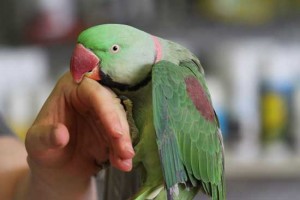
Introducing your new bird to an-existing bird
Once you take your bird home you should keep it in a separate cage and allow the bird to adjust accordingly. Always allow at least 2 weeks before introducing the bird to an existing bird. Mixing alexandrine parrots with other birds
Hand rearing Alexandrine parrots
Hand rearing should start at around 2 to 3 weeks of age as these birds get good bacteria from their parents and build a stronger immune system than baby birds incubated and not parent raised at all. There is a debate on methods of hand raising which some people believe spoon feeding is better than crop feeding. I have raised many birds over the years using both methods and I personally believe crop feeding is better as it’s not as messy as spoon feeding and does not have to invade the crop at all as birds willingly take the food in the side of their mouths. It’s very important when to never allow food to go under the tongue as this is where their windpipe is, and they may choke. When feeding babies never top up babies until they have fully digested there previous food as they can get a condition called sour crop. Hand rearing formular should always be made freshly there are a number of different hand rearing formulas available at birdsville from Murphy’s, vetafarm hand rearing formula, passwells hand rearing formula and wombaroo granivore. Over the years I’ve used all the different products and found they have all done the job well.
What to Look for When Purchasing an Alexandrine
When you are ready to purchase your new Alexandrine, here are so few hints for what to look for.
- Eyes – should be bright and clear, there should be no discharge, swelling or redness. If the eyes that are runny, squinty, or discolored can be an indication of infection.
- Condition- This is very important and should be understood by any bird owner as a bird handler every time i touch any bird i feel the bird’s condition by touching the birds keel bone which is underneath the bird this is the anchor where the birds large wing muscles attach to allow the bird to have strong wing muscles for flight. When a bird is unwell the first thing that usually happens is they lose weight, and their breast muscle becomes very light on. Because of birds very high metabolic rate they can lose weight very quickly and become ill so this should be checked by bird owners on a regular basis especially if they see there bird not as active as normal.
- Mouth and beak – should be clean and free of injury, no lesion, wetness or build up inside the mouth. The beak should not be overgrown.
- Nose, nostrils or cere – should be open and free of discharge.
- Feathers – the bird should be fully feathered and sleek with a smooth appearance. Depending on the age, sometimes the tail feathers will be somewhat ragged due to young birds regularly walking through there wet food and having them rub on objects and wire.
- Wing Clipping – We recommend letting the wings grow out but if wings are clipped then both wings should be clipped, not just one and all outer feathers should be cut. If the last two outer feathers are not cut the bird could injure themself and if only one wing is only clipped the bird still may fly, just lopsided and cause injury when landing. Birdsville will clip wing for free with any purchase.
- Weaning – it is highly recommended, if you don’t have hand raising experience, only weaned birds should be bought. Hand feed might look and seem like a simple process, but it can be easily done incorrectly and time consuming. Mistakes when hand feeding can cause irreversible harm and even lead to death of the young bird. Alway choose birds that are fully weaned and eating independently. Your bond with the bird will not suffer for it in the least.
- Dirty vent (anus) – there should be no staining or fecal matter on the feathers around the vent.
- Leg – should look clean.
- Clean enclosure – the enclosure where the birds are kept should be clean and hygienic, to reduce the likeliness of illness or infection.
- Active and alert – The bird should be active and alert. If it appears sluggish or weak it could be ill or too young to be feeding on its own.
